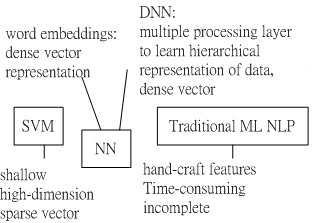Recent Trends in Deep Learning Based Natural Language Processing
Natural language processing (NLP) are computational techniques for the automatic analysis and representation of human language. NLP enables computers to perform natural language related tasks.

Fig.1 schematic of SVM (support vector machine), NN (neural network) and traditional machine learning based NLP system.
Fig. 1 shows the schematic of SVM, NN and traditional machine learning based NLP system.
Machine learning approaches targeting NLP problems have been based on shallow (cf. deep) models (e.g., SVM and logistic regression) trained on high dimensional and sparse features.
Neural networks based on dense vector representations have been producing superior results on various NLP tasks. This trend is sparked by the success of word embeddings [1] and deep learning methods [2].
Deep learning enables multi-level automatic feature representation learning. Deep learning methods employ multiple processing layers to learn hierarchical representations of data, and have produced state-of-the-art results in many domains [0].
Traditional machine learning based NLP systems relies on hand-craft features which are time-consuming and incomplete.
The deep learning framework outperforms state-of-the-art approaches in NLP tasks such as named-entity recognition (NER), semantic role labeling (SRL), and POS tagging [3].
 Fig. 1 Schematic for HMM (hidden Markov model), GMM (Gaussian mixture model) and DNN (Deep neural network).
Fig. 1 Schematic for HMM (hidden Markov model), GMM (Gaussian mixture model) and DNN (Deep neural network).
Fig.1 shows the schematic of hidden Markov models (HMMs), Gaussian mixture models (GMMs) and deep neural network (DNN).
The hidden Markov models (HMMs) can be used to deal with the temporal variability of speech.
The Gaussian mixture models (GMMs) can be used to determine how well each state of each HMM fits a frame or a short window of frames of coefficients that represents the acoustic input [4].
An alternative way to evaluate the fit is to use a feed-forward neural network that takes several frames of coefficients as input and produces posterior probabilities over HMM states as output.
Deep neural networks (DNNs) have been shown to outperforms GMMS on a variety of speech recognition benchmarks [4].
Deep learning methods and a technical overview of distributional semantics, i.e., word2vec and CNN, for NLP in a tutorial manner is present in [5]. Various models are summarized, compared in [0].
[0]
Young, Tom, et al. "Recent trends in deep learning based natural language processing." arXiv preprint arXiv:1708.02709 (2017).
[1]
T. Mikolov, I. Sutskever, K. Chen, G. S. Corrado, and J. Dean, ¡§Distributed representations of words and phrases and their compositionality,¡¨ in Advances in neural information processing systems, pp. 3111-3119, 2013.
[2]
R. Socher, A. Perelygin, J. Y. Wu, J. Chuang, C. D. Manning,
A. Y. Ng, C. Potts et al., Recursive deep models for semantic compositionality over a sentiment treebank," in Proceedings of the conference on empirical methods in natural language processing (EMNLP), vol. 1631, p. 1642, 2013.
[3]
R. Collobert, J. Weston, L. Bottou, M. Karlen, K. Kavukcuoglu, and P. Kuksa, ¡§Natural language processing (almost) from scratch," Journal of Machine Learning Research, vol. 12, no. Aug, pp. 2493-2537, 2011.
[4]
G. Hinton, D. Deng, D. Yu, G. E. Dahl, etc. ``Deep Neural Networks for Acoustic Modeling in Speech Recognition,"
IEEE Signal Processing Magzine, vol.82, November, 2012.
[5]
Y. Goldberg, ``A primer on neural network models for natu- ral language processing," Journal of Artificial Intelligence Research, vol. 57, pp. 345-420, 2016.